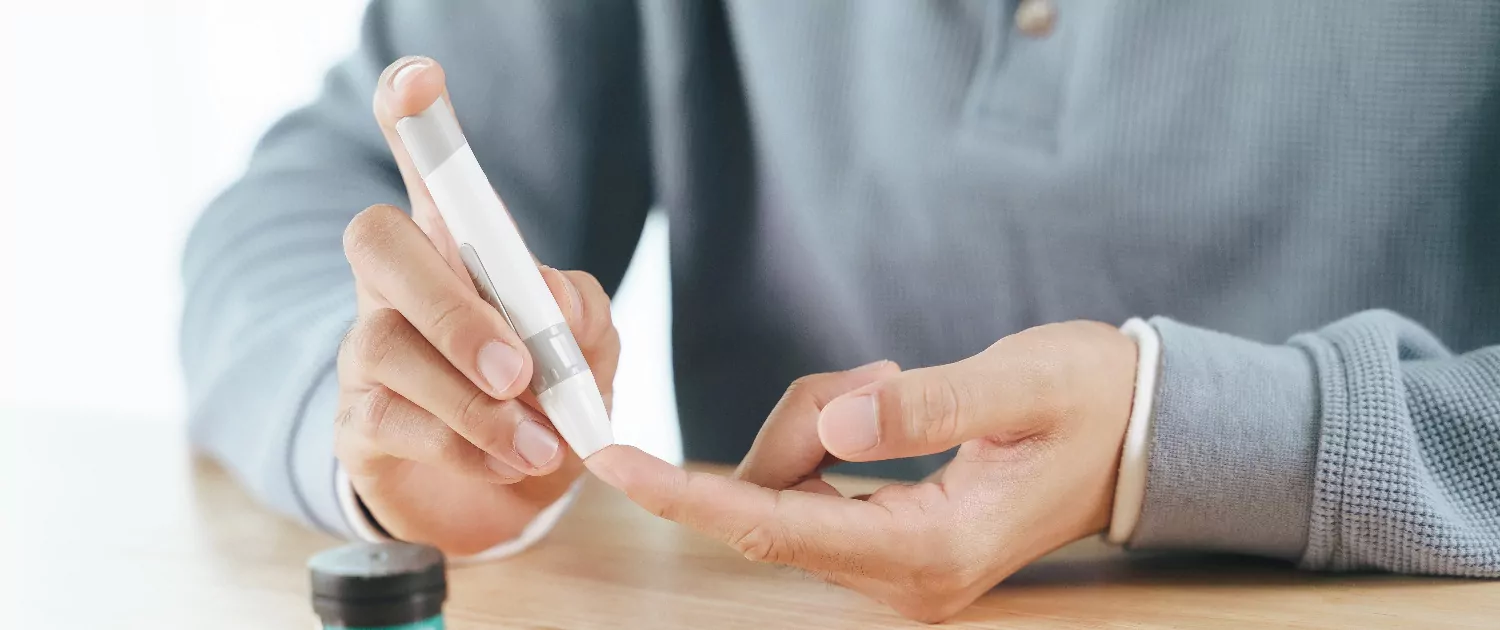How to Measure Insulin Resistance at Home?
Some body measurements and fasting blood glucose can be monitored for insulin resistance calculation at home. Fasting blood glucose of a healthy individual should be in the range of 70-100 mg/dL (1).
Waist circumference monitoring: Waist circumference is a determining factor for insulin resistance. You can regularly monitor your waist circumference at home and adopt healthy eating habits to stay within a healthy range. Waist circumference should be 88 cm in women and 102 cm or less in men (5). In addition, a figure of 80 cm in women and 94 cm and above in men is considered a risk factor (1).
Insulin and blood glucose monitoring: There are technologies to measure your insulin and blood glucose levels at home. You can obtain these devices by consulting your physician and pharmacist. You can also find out during regular health check-ups.
HOMA-IR value calculation: If you know your fasting blood glucose and insulin levels, you can use some formulas to find out if you have insulin resistance. You can find the HOMA-IR value by multiplying the fasting blood glucose (mg/dL) and fasting insulin value (microU/ml) in the blood test and dividing the result by 405 (1).
While the concept of insulin resistance is easy to understand, it is more difficult to understand who has insulin resistance. Insulin resistance, an underlying cause of most diseases, is a value that should be measured regularly. This is because information about these values can help both to get an idea about the general state of health and to diagnose a possible disease. There are multiple methods used to measure insulin resistance. However, which method will be used in the patient may vary according to the doctor’s recommendation or the patient’s condition.
This test, which measures the amount of insulin in the blood, should be performed immediately when certain symptoms appear. Although insulin resistance is often measured in hospitals, it is also possible to measure it at home. However, this may require some calculations. Specialized instruments and a trained person are needed to perform this test, which is done following specific procedures. The measured values are analyzed by a doctor and a conclusion is drawn. You can read the rest of the article to learn more comprehensive answers to questions such as what is insulin resistance and how to measure insulin resistance at home.

What is Insulin Resistance?
Insulin is a hormone secreted by the beta cells of the pancreas. It is secreted at certain times of the day and immediately after eating. The main task of secreted insulin is to deliver glucose from the blood to the cells and keep blood sugar at a certain level. However, in some cases the glucose that the cells need to use is not recognized by the cells. In this case, blood glucose levels remain too high and cells struggle because they don’t get the nutrients they need.
The answer to the question of what insulin resistance means is generally that the body responds less than normal to insulin. Insulin is a hormone secreted by the pancreas and helps the body cells absorb glucose to regulate blood sugar. In people with insulin resistance, cells become less sensitive to insulin. As a result, blood sugar levels rise. This can vary depending on many factors such as genetic predisposition, unhealthy diet and sedentary lifestyle.
Hyperinsulinemia (increased insulin levels in the blood) also occurs in individuals with insulin resistance. This can lead to fatigue of the pancreas and, in later stages, an inability to produce enough insulin. Since insulin is an anabolic (combining, synthesizing) hormone, a regular excess of insulin in the blood increases fat around the waist.
What are the Symptoms of Insulin Resistance?
Insulin resistance also increases the risk of developing type 2 diabetes. High levels of sugar in the blood cause the pancreas to produce more insulin in the future. This can lead to pancreatic fatigue and reduced insulin production.
Symptoms of insulin resistance can be varied and sometimes not obvious. However, common symptoms may include
- Increased appetite: People with insulin resistance may experience constant hunger and sudden food cravings.
- Low sugar (hypoglycemia): Blood sugar levels can drop, especially in cases of skipping meals or prolonged fasting. This can lead to symptoms such as dizziness, sweating and tremors.
- Abdominal fat Fat accumulation in the abdominal area may increase. This condition, also called “apple-type” obesity, is associated with insulin resistance.
- Fatigue: Individuals with insulin resistance may experience a constant state of fatigue.
- Frequent urination: The kidneys of people with insulin resistance produce more urine. This causes frequent urination and a feeling of tightness.
- High blood pressure: Insulin resistance may increase the risk of high blood pressure.
The answer to the question of how to break insulin resistance can be lifestyle changes such as weight loss, regular physical activity, a healthy diet and stress management. A healthy eating plan should include complex carbohydrates, fibrous foods, low-fat proteins and healthy fats.
Medical treatment may include medicines and insulin injections as directed by your doctor. Early diagnosis and treatment is important as diabetes and other health problems can develop if insulin resistance is left untreated.
Insulin resistance is seen in many individuals due to today’s living conditions. It is among the most important criteria of the condition called metabolic syndrome. Sedentary life, fast-food culture and stress factors increase the prevalence of waist circumference in individuals. Diagnosis is possible with blood tests and some body measurements. Medication and lifestyle changes may be recommended for the treatment of insulin resistance.
Individuals can improve insulin sensitivity by adopting a healthy diet plan and exercising regularly. You can find answers to questions such as “What does insulin resistance mean and how to break insulin resistance?” with this content. online health
What Should Insulin Resistance Be?
Insulin resistance is measured by a simple method called HOMA-IR. In individuals with insulin resistance, this value is 2.5 and above. Significant improvements in insulin resistance are seen with regular diet and exercise. For this, the individual should first have a blood test to find out his/her fasting blood sugar and insulin levels.
What are the Symptoms of Insulin Resistance?
Insulin resistance is directly affected by lifestyle and dietary habits. Depending on the variability of blood glucose levels, one or more of the following symptoms may occur:
- Appetite: Someone with insulin resistance may feel hungry constantly or sooner than they should.
- Hypoglycemia Prolonged fasting can be challenging for a patient coping with insulin resistance. Hypoglycemia is characterized by tremors in the hands and feet and dizziness.
- Fatigue: In insulin resistance, metabolic activities do not proceed in the order they should. Therefore, body fatigue is higher than in healthy individuals.
- Fat around the waist: In insulin resistance, the pancreas secretes insulin continuously. Increased insulin in the blood can lead to fat around the waist and in the internal organs.
How to Reduce Insulin Resistance?
The most important answer to the question “How to break insulin resistance?” is a healthy diet and regular exercise. These are essential even if the individual is on medication. Because, for permanent treatment, healthy weight loss should be achieved and body fat ratio should be brought to the ideal range. This can be done with the help of a nutritionist. The main criteria to be considered for an insulin resistance diet are as follows:
- Eating a diet with a low glycemic index (consuming carbohydrate sources that increase blood glucose levels more slowly),
- Getting enough protein and maintaining a calorie deficit,
- Consume fiber-rich meals rich in complex carbohydrates,
- Increase meal frequency,
- Drinking enough water is important for treating insulin resistance.
How to Measure Insulin Resistance at Home?
How to Measure Insulin Resistance at Home
The answer to the question of what insulin resistance should be is 100 mg/dl in a healthy person. Higher values may indicate that the patient has a serious condition. Several laboratory tests are needed to precisely measure insulin resistance. However, you can monitor whether you have insulin resistance at home with some indicators. Here are some ways to measure insulin resistance at home:
- Measuring waist circumference: Waist circumference indicates abdominal fat accumulation, which may be associated with insulin resistance. A waist circumference of more than 102 cm (40 inches) in men and more than 88 cm (35 inches) in women can increase the risk of insulin resistance.
- Monitoring blood glucose levels: High blood sugar can be an indicator of insulin resistance. You can monitor your blood sugar regularly with home blood glucose meters.
- Measuring fasting insulin levels: Fasting insulin levels can help identify insulin resistance. You can measure fasting insulin levels by asking your doctor or with home insulin tests offered by some health care providers.
- Performing the HOMA-IR calculation: The HOMA-IR (Homeostasis Model Assessment-Insulin Resistance) calculation, which you can do at home, is used as an indicator of insulin resistance. This calculation is based on fasting blood glucose and fasting insulin levels. The HOMA-IR calculator is available online.
These are methods you can use to calculate insulin resistance at home. However, for a definitive diagnosis, it is important to consult a healthcare professional and have the necessary laboratory tests performed.
Frequently Asked Questions
Insulin resistance affects daily life. Individuals diagnosed with insulin resistance should use the necessary medications in line with the physician’s warnings and recommendations. You can find some of the questions you may wonder about during the treatment process below.
Does Insulin Resistance induce Sleep?
Insulin resistance is a disease characterized by fluctuations in blood sugar and insulin levels. This can lead to fatigue and sleepiness.
How Should Insulin Resistance Medications Be Taken?
Insulin resistance medication should be taken regularly at the time prescribed by the physician.





